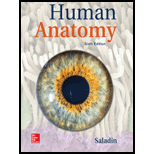
Components of the skeletal system, including but not limited to the bones
To determine:
The components of skeletal system.
Introduction:
The skeletal system provides the overall structure to the body. The bones, cartilages, ligaments and tendons make up the skeletal system. The ligaments are the structures that join two bones together. The tendons join the muscles to the bones. The foremost functions of the skeletal system are to provide physical support and to protect inner delicate organs of the body.
Answer to Problem 6.1.1AYLO
The components of skeletal system are cartilage, tendons, joints and ligaments.
Explanation of Solution
The skeletal system is the system that provides shape, structure, protection to the body. It also plays a major part in the maintenance of the electrolyte balance of the body. The blood cell lineages are also produced by the hematopoietic cells present in the bone marrow of the bones. The movement and locomotion of the body is possible only by the virtue of bones in the body.
The skeletal system is mainly made up of bones but other than the bones there are components like;
- Cartilage:
The cells that make up the cartilage are known as the chondrocytes. The chondrocytes together form the fibrous connective tissue in integration with the gelatinous matrix called chondrin. The presence of this rubbery gelatinous matrix makes the cartilage very flexible and this flexibility support the structures like nose, ears, trachea etc. There are three kinds of cartilage: hyaline cartilage that forms bone, fibrous cartilage that is present in the joint capsules and elastic cartilage that are found in the external ear.
- Tendons:
Tendons are also the fibrous connective tissue that connects bone to the muscle. The property to withstand tension is the characteristic feature of a tendon.
- Joints:
The portion of the body where two skeletal structures especially the bones join is known as a joint. The joints usually facilitate the movement of the bones. According to the structures, the joints can be divided as the fibrous, synovial and cartilaginous joints. The functional classifications of the joints include the immovable joints, slightly movable joints and the freely movable joints.
- Ligaments:
The structures that join bone to a bone are called as the ligaments. These are also a form of fibrous connective tissue.
Thus, the above mentioned components are the components of the skeletal system other than the bones.
Thus, the components of skeletal system are cartilage, tendons, joints and ligaments.
Want to see more full solutions like this?
Chapter 6 Solutions
HUMAN ANATOMY
- How is a protein destined for the Endoplasmic Reticulum (ER), imported into the ER? Be concise.arrow_forwardFind out about the organisations and the movements aimed at the conservation of our natural resources. Eg Chipko movement and Greenpeace. Make a project report on such an organisation.arrow_forwardWhat are biofertilizers and mention the significancearrow_forward
- PCBs and River Otters: Otters in Washington State’s Green-Duwamish River have high levels of polychlorinated biphenyls (PCBs) in their livers. PCBs can bind to the estrogen receptors in animals and disrupt the endocrine system of these otters. The PCBs seem to increase the estrogen to androgen ratio, skewing the ratio toward too much estrogen. How would increased estrogen affect the river otter population? Based on your reading of the materials in this unit, what factors can affect fertility in humans? Explain how each of the factors affecting human fertility that you described can disrupt the human endocrine system to affect reproduction.arrow_forwardOther than oil and alcohol, are there other liquids you could compare to water (that are liquid at room temperature)? How is water unique compared to these other liquids? What follow-up experiment would you like to do, and how would you relate it to your life?arrow_forwardSelection of Traits What adaptations do scavengers have for locating and feeding on prey? What adaptations do predators have for capturing and consuming prey?arrow_forward
- Competition Between Species What natural processes limit populations from growing too large? What are some resources organisms can compete over in their natural habitat?arrow_forwardSpecies Interactions Explain how predators, prey and scavengers interact. Explain whether predators and scavengers are necessary or beneficial for an ecosystem.arrow_forwardmagine that you are conducting research on fruit type and seed dispersal. You submitted a paper to a peer-reviewed journal that addresses the factors that impact fruit type and seed dispersal mechanisms in plants of Central America. The editor of the journal communicates that your paper may be published if you make ‘minor revisions’ to the document. Describe two characteristics that you would expect in seeds that are dispersed by the wind. Contrast this with what you would expect for seeds that are gathered, buried or eaten by animals, and explain why they are different. (Editor’s note: Providing this information in your discussion will help readers to consider the significance of the research).arrow_forward
- Understanding Health Insurance: A Guide to Billin...Health & NutritionISBN:9781337679480Author:GREENPublisher:Cengage
 Human Physiology: From Cells to Systems (MindTap ...BiologyISBN:9781285866932Author:Lauralee SherwoodPublisher:Cengage Learning
Human Physiology: From Cells to Systems (MindTap ...BiologyISBN:9781285866932Author:Lauralee SherwoodPublisher:Cengage Learning Human Biology (MindTap Course List)BiologyISBN:9781305112100Author:Cecie Starr, Beverly McMillanPublisher:Cengage Learning
Human Biology (MindTap Course List)BiologyISBN:9781305112100Author:Cecie Starr, Beverly McMillanPublisher:Cengage Learning Medical Terminology for Health Professions, Spira...Health & NutritionISBN:9781305634350Author:Ann Ehrlich, Carol L. Schroeder, Laura Ehrlich, Katrina A. SchroederPublisher:Cengage Learning
Medical Terminology for Health Professions, Spira...Health & NutritionISBN:9781305634350Author:Ann Ehrlich, Carol L. Schroeder, Laura Ehrlich, Katrina A. SchroederPublisher:Cengage Learning





